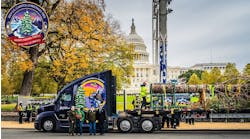Owner-operators and large trucking companies share many of the same concerns about the proposed speed limiter requirement for heavy-duty trucks. But while the big fleets generally support the underlying concept of the standard, independents overwhelmingly reject the idea that the federal government should be making operational decisions for truckers.
The Owner-Operator Independent Drivers Assn., representing more than 150,000 small-business truckers, says that its members are “vehemently opposed” to mandatory speed limiters because such devices are “counterproductive” to safety.
Among the OOIDA concerns:
- mandatory speed limiters will increase the number of vehicle “interactions” at highway speeds
- the proposal doesn’t address the “stress and fatigue” impact that the rule would have on driver health; and
- the NPRM doesn’t pay “sufficient attention” to the negative economic impact on small trucking companies
“Relying on technological mandates like speed limiters provides a false sense of security and ignores the contribution to safety made by drivers and the importance of the driver having the ability to engage in critical decision making,” OOIDA writes.
OOIDA suggests that the mandate is prompted by the competitive needs of larger, speed-limited fleets, both in terms of customers service and driver retention.
“Instead of relying upon concrete evidence and data about actual motor carrier and driver experience associated with speed limiters, the agencies have resorted to postulating a theoretical reduction in crash severity and environmental benefits,” the group says.
OOIDA also questions the sufficiency of the proposed rule, noting the agencies haven’t done enough research for an effective public review and comment.
The National Association of Small Trucking Companies suggests the proposed rule doesn’t pay adequate attention to “important counterfactuals” such as speed differentials, a resulting increase in traffic density, a likely growth in impatience and risk-taking by impatient private motorists, and a greater risk of crashes because speed limiters reduce a truck driver’s options in reacting to events on the road.
“These are not hypothetical arguments,” the group writes. “Presented here are real-world factors and conditions seen every day on highways by NASTC members' drivers, concerns of our member companies, and public comments voiced by hundreds of professional drivers in statements already filed in the rulemaking docket. We conclude that the proposed rule would decrease highway safety and jeopardize millions more motorists, both commercial and private, more frequently.”
Additionally, the association makes a the case that speed limiter mandate debate “really boils down to a big business versus small business matter,” and that the decision to limit speed should be voluntary and based on individual company considerations.
“Megafleets have made the business decision to outfit their trucks with speed limiters. Now, they want the government to impose the same thing on their more numerous but smaller competitors, whether it makes business sense for these smaller operators or not,” NASTC says. “Safety is a secondary consideration in this dollars-and-cents business decision. This is an illegitimate reason for such a public policy.”
Finally, NASTC argues that the agencies haven’t fully considered the business impact of the proposal.
“NASTC believes, based on 25+ years engaging small, long-haul carriers, that the agencies underestimate ‘the type and magnitude’ of this rule's adverse effects, not only of putting viable companies and operators out of business, but its constraint of capacity, associated costs of longer delivery times, reduction of competitors resulting in sectoral consolidation and loss of options for shippers and brokers, and qualitative differences in the ability and experience of the commercial driving pool,” the comment states.
The Trucking Solutions Group points out the in the Northeast, for instance, where speed limits are typically 55 or 60 mph, “a speed limiting device will have no effect whatsoever.” TSG explains that speed limits that are set by traffic engineers who are best able to determine the maximum safe speed, and that exceeding posted limits is the primary safety hazard.
“An arbitrarily set, one-size-fits-all speed limiting device as proposed in this NPRM can hardly do justice to those who are best able to determine the maximum safe traveling speed for a particular roadway,” the group writes. “We need better speed enforcement without creating the safety hazard that accompanies this NPRM.”
As do other owner-operators, TSG also makes the case that the mandate is a business competition matter, not a safety one, and the rulemaking is “overreach” by FMCSA.
“We flatly reject the premise that federal agencies should be used as tools of the ATA member mega-carriers to level the playing field while the ATA members already enjoy sweeping competitive advantages,” TSG comments. “Where the TSG’s members are single truck or small fleet operators, the owner-operator with his or her vast experience is the best person to determine what is the safe operating speed given the conditions at that precise moment. … The ATA’s proposal that resulted in this NPRM is simply a competitive ploy, thinly veiled under the cloak of safety, perverting the regulatory environment for its members’ competitive advantage.”
Of course, thousands of drivers offered individual comments. This short statement by Scott Friede is representative: “You're asking for rolling roadblocks, differentiated speeds between cars and trucks? No. Those both are absolute an accident waiting to happen. No thank you.”
In the next collection, roadside enforcement offers their take on the proposal.




